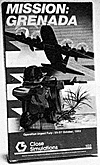
Designed by Wayne C. Close
Close Simulations
PO Box 2247, Northbrook, IL 60062
Released: June, 1985
Catalog No. 103
Price $7.00
Complexity: Intermediate
Solitaire Suitability: Good
**
Mission: Grenada is a two-player tactical level game of the U.S. invasion of the island nation of Grenada during October, 1983. The game comes in the small pocket box format and includes an unmounted 14 X 15 inch map sheet, 112 die-cut counters and a plastic bag for counter storage.
Physically, the game is an enigma. The box art is a first class effort but once the box is opened things rapidly go downhill. The counters are well done with some nice symbols being used rather than the usual box symbology. The U.S. counters tend to blend into the jungle hexes and are hard to read, being black on dark green. The game map is something else! Lurid may he the kindest thing to say about this effort. Red contour lines wander across dark green jungle which is then brought all the more into contrast with red/white heaches and the white clear terrain.
The color schcrne is reminiscent of the historical games that Mayfair Games Inc. brought out a few vears ago. I thought that graphics person had been exiled, but hes back with a vengeance for this map sheet. Red, white, and green counters being moved on this map sheet is not for the weakstomached. Even a punk rocker wouldn't be caught dead with this item in his possession.
Fortunately, the game system is not as had as the physical components. The sequence of play consists of: U.S. action phase, U.S. contact removal phase, Cuban/Grenadian action phase, and the Cuban /Grenadian contact removal phase. The action phase is a comhination movement/combat phase in which players may perform movement and/or combat operations up to their action point allowance which is indicated on the unit counter. Some examples of permissible actions are airlifts, hasty attacks, full attack, movement, and reorganization. The concept of an action phase is well clone and works well and seems to be the new idea in wargaming. It accurately portrays the ebb and flow of combat operations compared to the old movement phase/combat phase that is all too well known.
Combat is part of the action phase and consists of close assaults (within hex), adjacent attacks, and ranged fire combat. Ranged fire involves air strikes, artillery or mortar fire and requires a line of sight or the target unit must be spotted. The effectiveness of modern weapons is accounted for by allowing column shifts on the Combat Results Table (CRT) when different weapon types encounter each other. American forces can also use combined arms attacks (armor and infantry) to achieve better odds. The CRT employs retreats, disorganization, and elimination results. Retreats can he reduced by the defender to contact results (unit loses half of its action point allowance) or contact plus disorganization results so as to hold a critical position. Other rules of note that are included are rules for air defense, paradrops, and amphibious landings.
The game includes three scenarios: The first critical hours, the first day, and the campaign game. Within a scenario, the U.S. player can opt for one of two available Orders of Battle (OB). The basic difference between the OBs is that the Ranger units are not available in one of them. Victory is determined by the accumulation of victory points. Victory points are awarded for evacuating the Governor General and the Medical Students; capturing Point Salines, the radio station, the fort, and the urban areas of the island; discovering arms caches; and destroying enemy units.
As the American player, your objectives are pretty clear: Capture Point Salines and evacuate the Governor General and the Medical Students. Your air units should be used to knock out the Cuban air defense units and the SAMs or else these units will cause headaches in the end game. Any attacks should he made at the best odds possible so as to avoid losing any units as the penalty in victory, points for casualties is a stiff one indeed and accurately reflects the political realities of the time. If you are the Cuban player, it is most important to deploy properly. Your air defense units should be concentrated to achieve maximum effect. The Govenor General and the medical students should be adequately guarded. Point Salines should be held as long as possible and as many casualties inflicted on the Americans so as to offset the victory points that the American will get for occupying the island. The loss of an American unit can spell victory for the Cuban player.
Overall, I was disappointed with the game. The game components were below par, especially the map sheet. The rules were clear and had some innovative concepts, such as the action point allowance and the retreat option in combat, but these were not enough to save the game. In addition there was little suspense to the game: All the American player has to do is plan his attacks carefully and there is little the Cuban/Grenadian player can do to avoid defeat.
The game simulates the historical event all too well! in short, there is too little to distinguish this game from other more playable and replayable games that are available these days.
More War Game Reviews
-
Game Review: Norseman: Viking Kingdom's of the North Sea, 900-1050 A.D.
Game Review: The Great Invasion ACW 1863
Game Review: Imperium Galactum A Strategy Game of Space Exploration and Conquest
Game Review: Mission: Grenada
Game Review: Cobra: The Game of the Normandy Breakout
Game Review: Reach for the Stars: The Conquest of the Galaxy
Back to Table of Contents -- Game News #11
To Game News List of Issues
To MagWeb Master Magazine List
© Copyright 1986 by Dana Lombardy.
This article appears in MagWeb (Magazine Web) on the Internet World Wide Web.
Other military history articles and gaming articles are available at http://www.magweb.com